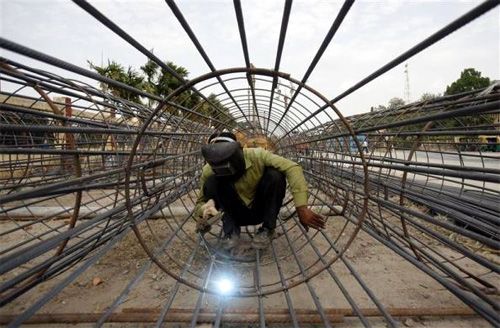 Even as policymakers are pinning hope on economic recovery in the second half of the current financial year, the revival remains elusive on two major fronts, industry and services.
Even as policymakers are pinning hope on economic recovery in the second half of the current financial year, the revival remains elusive on two major fronts, industry and services.
Industrial growth is unlikely to perk before the Lok Sabha polls, as uncertainty looms large over the economy, said observers. The industrial growth data for November, to be released on Friday, is likely to show a rise of only 1-1.5 per cent, economists said.
“By our estimate, the rise in industrial production will likely be around 1.5 per cent, subdued growth,” said Aditi Nayar, senior economist at ICRA Ratings. Industrial production had contracted 1.8 per cent in October and was flat during the first half of the financial year.
The eight infrastructure industries which contribute 38 per cent to the Index of Industrial Production expanded by 1.7 per cent in November against 5.8 per cent a year before.
The Purchasing Managers’ Index (PMI) pointed to low expansion; it was at 51.3 points in November, slightly up from 49.6 the month before. A reading above 50 shows expansion.
Economists said recovery was unlikely before the general elections. “There are no signs which point to that and I expect stagnation in industries for this year,” said Madan Sabnavis, chief economist at CARE Ratings. He said there could be a comeback only in the second quarter of the next year.
Sabnavis said as the Union budget for 2014-15 would come late, there would be a sense of uncertainty and even monetary policy of the Reserve Bank of India would be unclear.
Others were sceptical about investor confidence. “Investors would not be confident and even foreign direct investment will not show a pick-up before the elections,” said Nayar.
Services, which account for the biggest share of India’s GDP, might continue to grow at low rates in the second half of 2013-14
as well. Services were the biggest let-down in the second quarter of this financial year. The tertiary sector rose at an almost 12-year-low pace of 5.7 per cent in July-September against 6.2 per cent growth in the first quarter this year and 7.1 per cent in the same period last year.
If PMI is any indication, the situation does not seem to be growing any better. PMI for services remained below 50 points for a sixth month in a row till December. "There will be only modest growth in services, coming only from financials and the transportation sector. One cannot expect any support from the government end, as it is under a huge fiscal burden," said Sabnavis.
Experts were optimistic of some pick-up in economic growth because of the farm sector. The sowing of rabi crop was on target, Sabnavis said. Rabi sowing was up by nearly six per cent as on December 20, compared with the same period a year before.
The consumption in rural areas has been high because of the boost provided by the agricultural sector. “Some rural-oriented segments have shown growth such as two-wheeler and tractor production which is agriculture-driven growth,” said Nayar.
However, she pointed to lethargic growth in some durable goods such as gems and jewellery, which she said could be corrected only with a change in the policy.
Consumer durables showed a contraction in production by 11 per cent in April-October, compared to five per cent growth in the same period last year.
India's economic growth was below four per cent for a fourth straight quarter in July-September. It grew 4.4 per cent in the first quarter and 4.8 per cent in the second.
The Prime Minister, at his rare press conference, had said the economy was looking up. Later at the Pravasi Bharatiya Diwas, he seemed a bit modest, saying the economy would probably grow at the same rate as in 2012-13. The economy expanded at a decadal low of five per cent in 2012-13.
Even for a five per cent growth, the economy needed to expand by 5.3 per cent in the second half.

 Even as policymakers are pinning hope on economic recovery in the second half of the current financial year, the revival remains elusive on two major fronts, industry and services.
Even as policymakers are pinning hope on economic recovery in the second half of the current financial year, the revival remains elusive on two major fronts, industry and services.